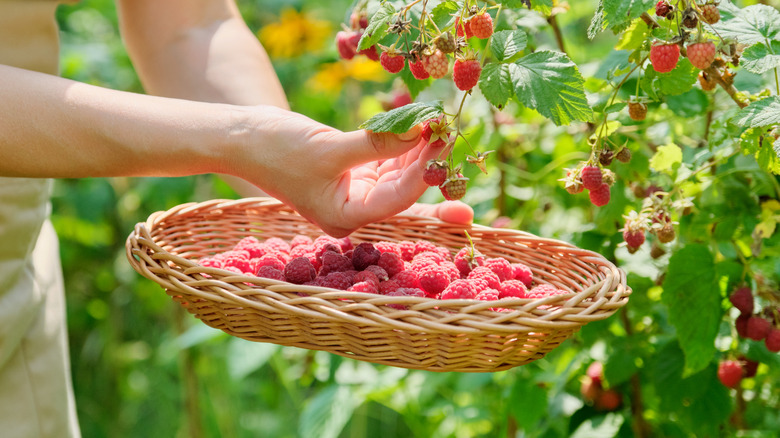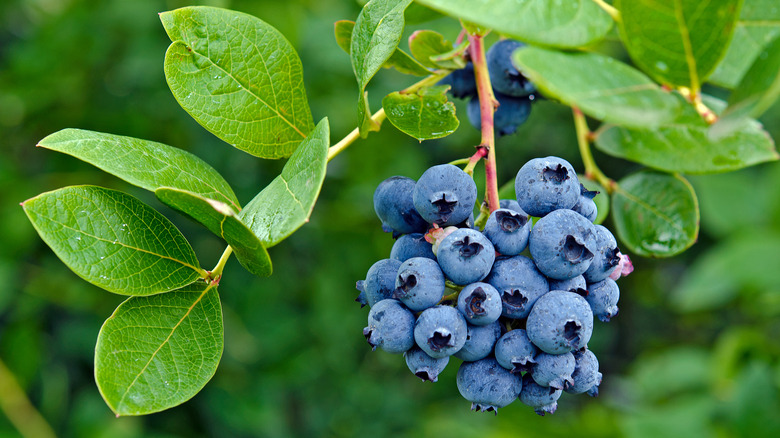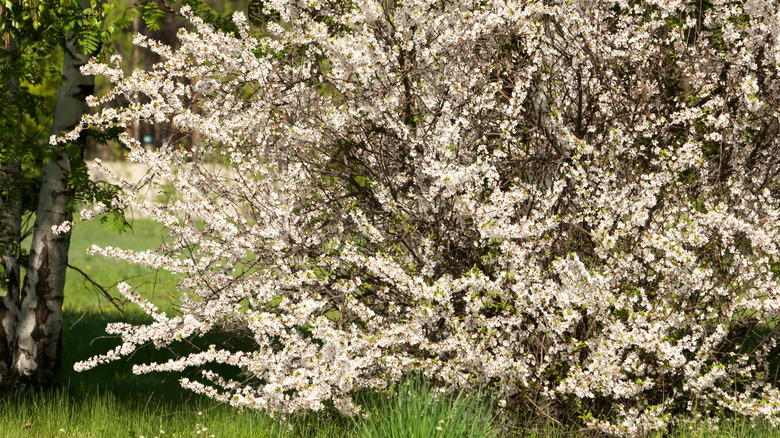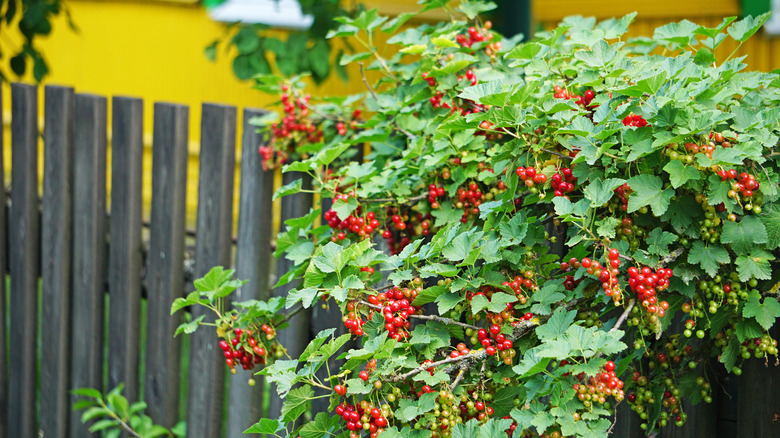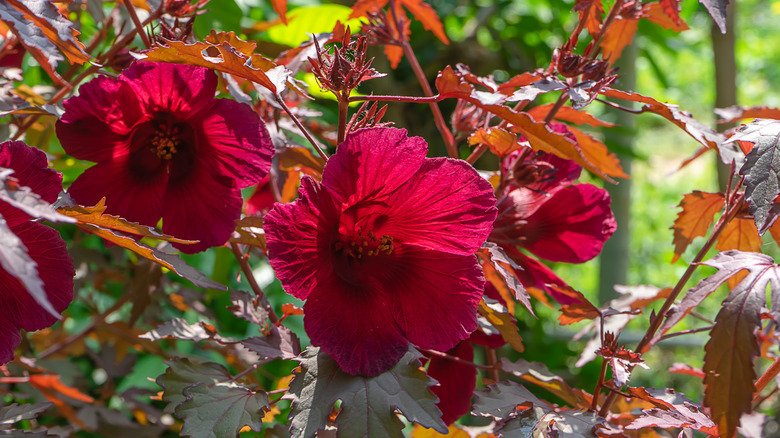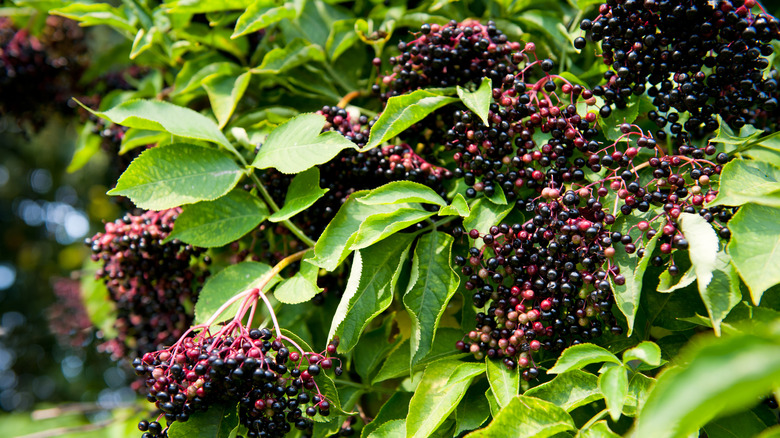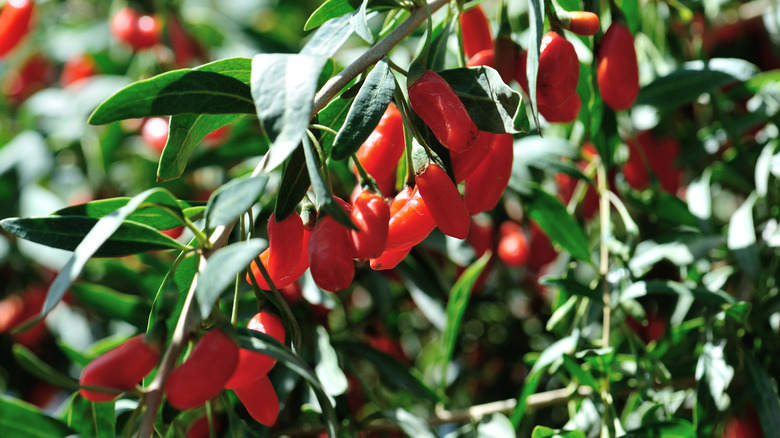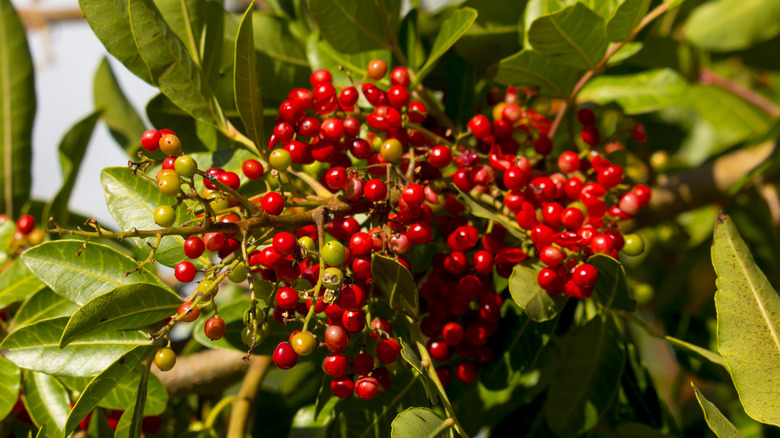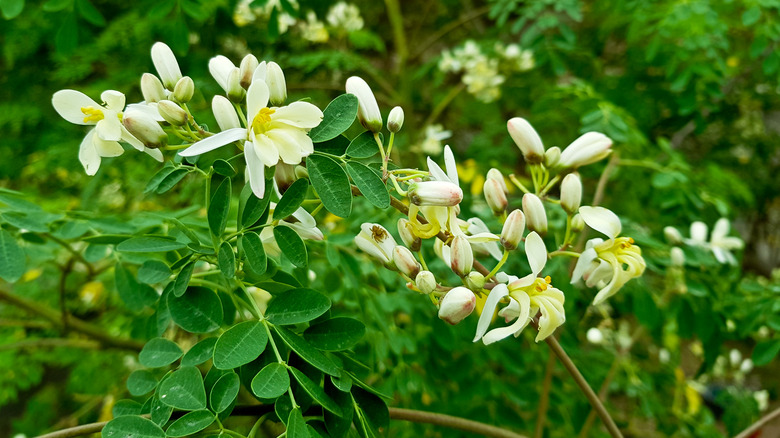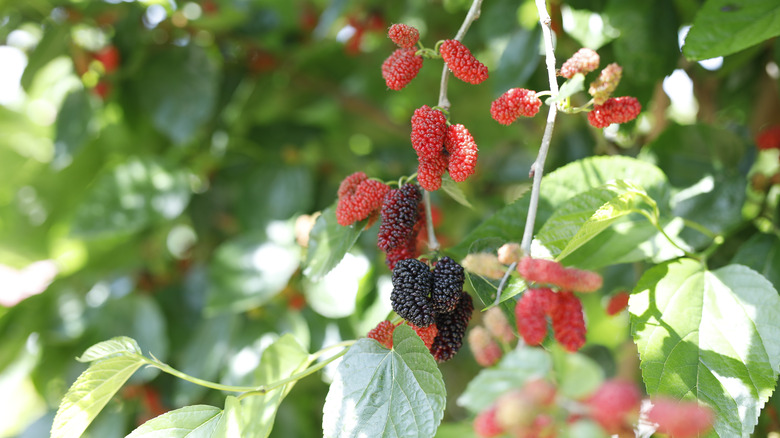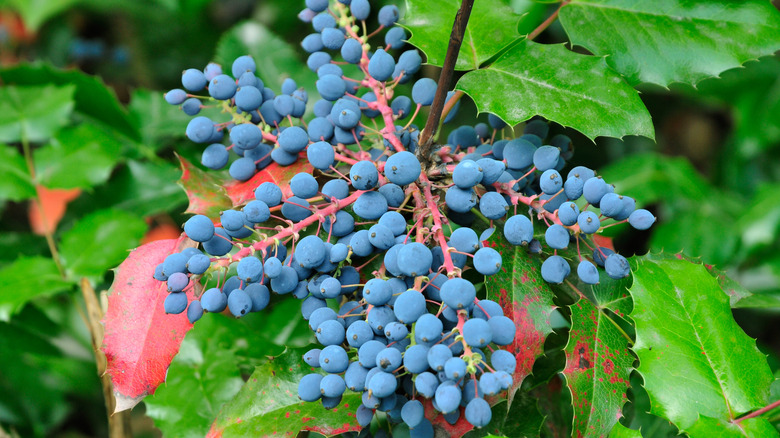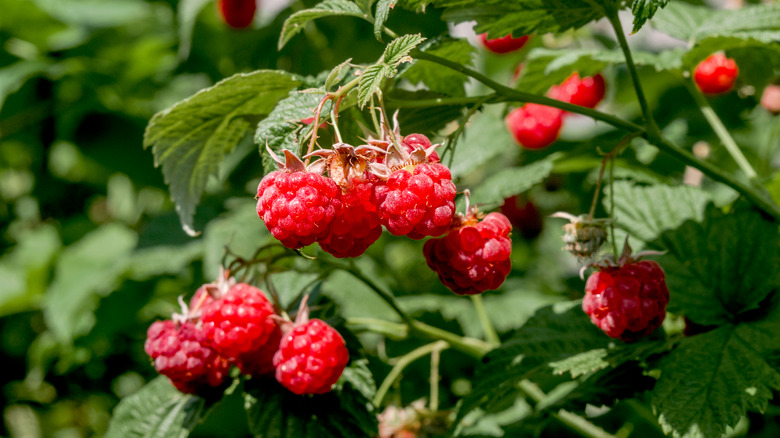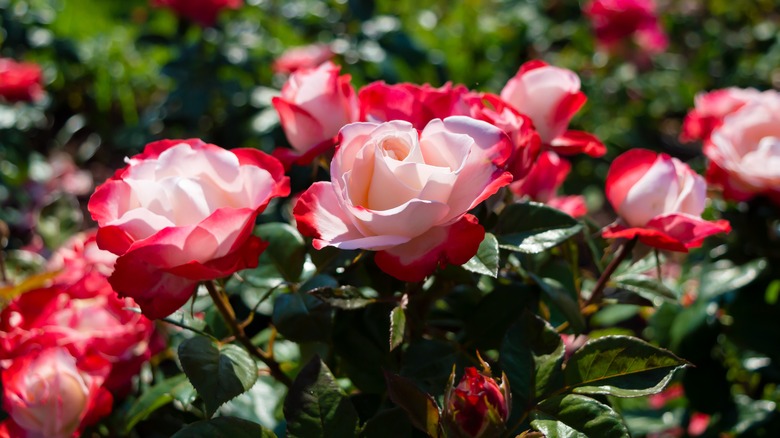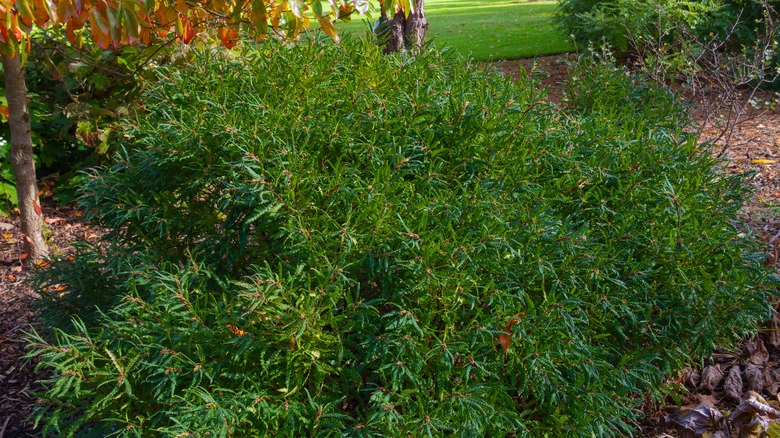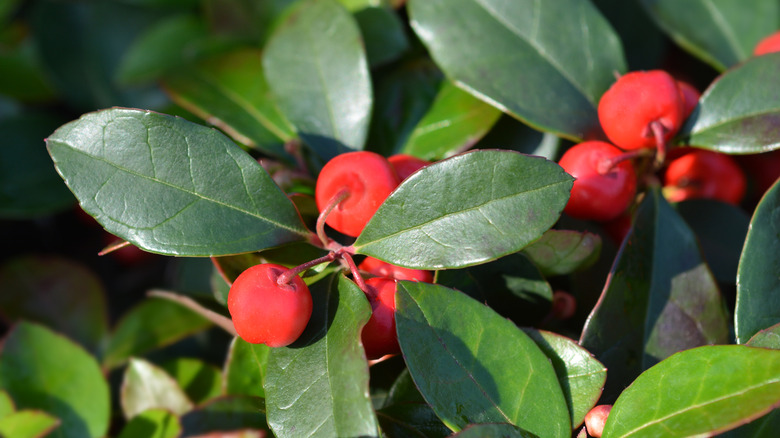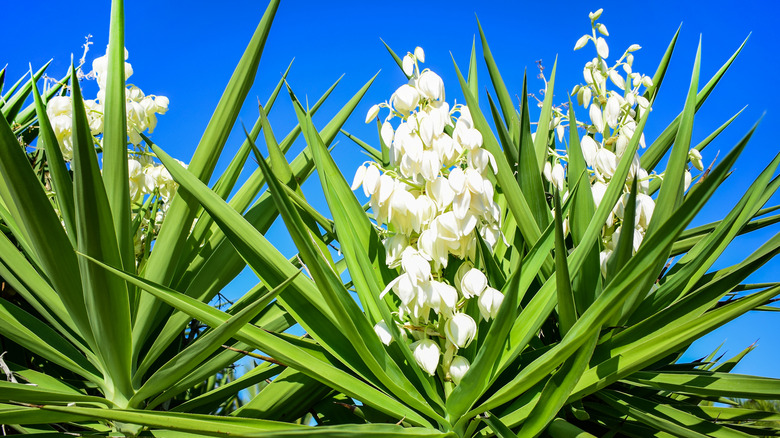15 Shrubs With Edible Parts You Can Grow In Your Yard
Collecting food from the vegetable patch is a beloved ritual for many, but at the end of the day, let's be honest that not all of us are blessed with green thumbs and the devotion of a patient gardener. It's still possible to have a yard bursting with flavor, though. And the best way to accomplish that could be in the form of edible shrubs. Generally easy to grow and often quite tolerant of a range of environmental conditions, there are shrubs that offer edible fruits and others with seeds and leaves that can be crushed into spices and teas.
Foraging, as defined by BBC Good Food, is technically all about collecting free food from out in the wild much like our ancient ancestors did, but at House Digest, we think your backyard is as good a spot as any to dig around in pursuit of the delicious. Whether you want to pretend you're genuinely foraging the great depths of uncharted forests or you're just looking for a sweet respite while you're out there mowing the lawn in blazing heat, a landscape dotted with edible shrubs will make for fun times and tasty treats. So let's take a look at 15 options you can look forward to planting next season.
1. Blueberry bush
Sweet and delicious, we all know blueberries (genus Vaccinium) are perfect on their own or mixed and baked into any number of satisfying dishes. Note that acidic soil is an absolute must for successfully growing blueberries; the Arbor Day Foundation recommends working with local gardening professionals to attain the proper pH levels in your yard.
Bloom Season: Summer
USDA Growing Zone: Depends on the cultivar (via My Little Green Garden)
Growing Conditions: Full sun
Soil Type: Moist, acidic, well-draining
Size: 2 to 4 feet tall and 2 to 12 feet wide
2. Cherry bush
Once you've got the blueberry bushes thriving, why not add some cherries to the orchard? When you're ready to get planting, Edible Landscaping recommends the Nanking white bush cherry (Prunus tomentosa) for the sweetest fruit. It's also a strong contender for a windbreak hedgerow (via Plants for a Future).
Bloom Season: Spring
USDA Growing Zone: 3 to 9
Growing Conditions: Full sun to partial shade
Soil Type: Tolerant of a range
Size: Up to 5 feet tall and 6 feet wide
3. Currants
Ribes rubrum is the botanical name of the medium-sized shrub that produces bright red currants. According to the Balkan Ecology Project, these bushes are quite tolerant of shade and very much prefer the moist soils found along riverbanks. Tart currant berries, rich in vitamin C, are popular ingredients for jams and jellies. They'll also play well with citrus in an orange-currant muffin recipe, says Betty Crocker.
Bloom Season: Spring
USDA Growing Zone: 4 to 8
Growing Conditions: Partial shade
Soil Type: Cool, moist, rich, well-draining
Size: 3 to 6 feet tall and wide
4. Cranberry hibiscus
For an edible hibiscus flower, stick with the Hibiscus acetosella variety because not all hibiscuses can be consumed. Per A Natural Farm, flower petals add a nice bite to salads and they're often used to make tea. As part of a landscape design, the University of Madison-Wisconsin suggests this plant for a seasonal hedgerow or a standout addition to the perfect cottage garden. Anyone for midday tea?
Bloom Season: Fall
USDA Growing Zone: 8 to 11
Growing Conditions: Full sun to partial shade
Soil Type: Tolerant of a range
Size: 6 to 10 feet tall and wide
5. Elderberry
Many berries make delicious snacks, but some are important in the field of wellness, too. This is certainly true of the elderberry (Sambucus canadensis), with Healthline claiming it to be in use medicinally worldwide. Planting a shrub in your yard will invite a wide range of birds, mammals, and maybe even hungry neighbors to the yard to snack on the tasty berries (via NC State Extension Gardener).
Bloom Season: Spring and summer
USDA Growing Zone: 4 to 8
Growing Conditions: Full sun
Soil Type: Moist, clay, loam, sand
Size: 5 to 12 feet tall and 6 to 10 feet wide
6. Goji berry bush
When botanists say Lycium barbarum, they're referring to the goji berry bush, well known for its little red fruits that are packed with vitamins, amino acids, and antioxidants. You can grow a shrub by seed, but if you're anxious to enjoy the fruit, then Grow Organic suggests getting your hands on a potted plant that's already been growing for a while.
Bloom Season: Summer and fall
USDA Growing Zone: 3 to 10
Growing Conditions: Full sun to partial shade
Soil Type: Average, well-draining
Size: 10 to 13 feet tall and up to 4 feet wide
7. Japanese pepper tree
As its name helpfully suggests, the Japanese pepper tree (Zanthoxylum piperitum) has seeds that can stand in for black pepper when crushed. A similar spice can be made out of the leaves and bark as well, notes Plants for a Future. Drainage will prove vital in the garden but this shrub can handle a range of sun exposure and shade.
Bloom Season: Spring
USDA Growing Zone: 5 to 9
Growing Conditions: Full sun to partial shade
Soil Type: Tolerant of a range
Size: 6 to 15 feet tall and 6 feet wide
8. Moringa
While many plants listed here offer delicious berries, the moringa (Moringa oleifera) shows them all up. According to the Food and Agriculture Organization, everything on this shrub can be consumed, from bark to seeds to tubers, roots, and flowers. Even the leaves contain vitamins, minerals, and protein, and are recommended for nursing mothers. Be prepared to mind this fast-growing shrub; Epic Gardening notes it can shoot up nearly 10 feet in a single year.
Bloom Season: Summer
USDA Growing Zone: 9 to 10
Growing Conditions: Full sun
Soil Type: Sandy, well-draining
Size: 20 to 50 feet tall
9. Mulberry
You'll need lots of space for a red mulberry bush (Morus rubra), which can grow up to 60 feet, advises NC State Extension Gardener. The kicker with mulberries is that sweet ripened fruit is perfectly safe to eat, however, unripe fruit can cause hallucinations and gastrointestinal distress. Note that the white variety (Morus alba) is considered an invasive weed, also per NC State Extension.
Bloom Season: Spring
USDA Growing Zone: 4 to 9
Growing Conditions: Full sun to deep shade
Soil Type: Rich, moist, well-draining
Size: 25 to 60 feet tall and 35 to 40 feet wide
10. Oregon grape
With preferences of either dry or moist soil and anything from full shade to absolutely zero shade, we can assume the Oregon grape bush (Mahonia aquifolium) is going to grow no matter where you plant it. Plants for a Future suggests it for a woodland garden, noting that its large bunches of fruit are particularly easy to gather.
Bloom Season: Winter and spring
USDA Growing Zone: 4 to 8
Growing Conditions: Tolerates shade
Soil Type: Sand, loam, or clay
Size: Up to 6 feet tall and 5 feet wide
11. Raspberry bush
A full day of direct sun exposure and well-draining soil are necessary for a flourishing raspberry bush (Rubus spp.), advises the Old Farmer's Almanac. Make sure your bushes are sheltered from strong winds yet still receive adequate air circulation. Prune annually and enjoy berries fresh from the stem. Remember to save a few to mix with yogurt or into a fruit smoothie.
Bloom Season: Summer and fall
USDA Growing Zone: 2 to 8
Growing Conditions: Full sun
Soil Type: Rich, moist, well-draining
Size: 4 to 5 feet tall and wide
12. Roses
Stunning beauty and edibility, too? Per Schisandra & Bergamot, all varieties of rose petals are safe to consume and, as a flavoring, they're often compared to strawberries; some may even improve immune system function. The Royal Horticultural Society suggests deadheading spent blossoms throughout the season and pruning your bushes annually.
Bloom Season: Summer and fall
USDA Growing Zone: Varies depending on cultivar
Growing Conditions: Full sun to partial shade
Soil Type: Rich, moist, well-draining
Size: Varies depending on cultivar
13. Sweet fern
Sweet fern (Comptonia peregrina asplenifolia) is not a fern but it's definitely sweet in fragrance and earthy in flavor, notes the Backyard Forager, a wild edibles blogger who suggests using the leaves as a rub for fish and meat dishes. Prairie Nursery adds that this plant belongs to the same botanical family that gives us the bay leaf.
Bloom Season: Spring
USDA Growing Zone: 2 to 6
Growing Conditions: Full sun to partial shade
Soil Type: Tolerant of a range
Size: 2 to 5 feet tall
14. Wintergreen
If you've got a backyard full of shade, you might try growing wintergreen (Gaultheria procumbens), a member of the blueberry family which may be labeled eastern teaberry. According to NC State Extension Gardener, wintergreen oil for chewing gum comes from the flowers and leaves. Although it's a low-growing ground cover plant, wintergreen is indeed classified as a shrub, confirms Adirondacks Forever Wild.
Bloom Season: Summer
USDA Growing Zone: 3 to 7
Growing Conditions: Dappled sunlight, partial to deep shade
Soil Type: Moist yet well-draining
Size: 4 to 8 inches tall and 6 to 12 inches wide
15. Yucca
Head to the southeastern United States to find wild yucca (Yucca filamentosa) growing along beaches and sand dunes. The Missouri Botanical Garden says you should have little trouble growing this evergreen shrub that can tolerate everything from drought to erosion to salt runoff from roads. In a recipe, James Beard award-winning chef Hank Shaw suggests tempura-fried yucca petals with mesquite seasoning. Yum!
Bloom Season: Summer
USDA Growing Zone: 5 to 10
Growing Conditions: Full sun
Soil Type: Light, dry to medium, well-draining, tolerant of sand
Size: 4 to 8 feet tall and 2 to 3 feet wide
